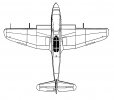First hats off to you on the model work to have the time and skill to do that is truly beyond me. But the length of the nose on that bird feels weird when I look at it. Maybe it's just me idk. Once again great work on the model.F4U7 Inline Corsair RNZAF service 1945
The Corsair was in 1942 proving itself in US Navy service. It was powerful, it was fast and it was troublesome. It was subject to “bounce” on landing during sea trials. The US Navy was disappointed in it’s deck landing trials onboard it’s carriers. It was assigned to the Royal Navy and the US Marines or it operated ashore in US Navy units.
In 1942, Chance Vought proposed an inline powered version to the USAAF. The USAAF wasn’t interested in what it saw as a discarded US Navy design. However, the US Marine Corps was intrigued at the possibilities. The Allison engine, equipped with a turbo charger was substantially faster that the standard radial engined version. So they ordered 100 of the aircraft. However, it’s development was troubled. The aircraft was found to be a handful. The US Marine Corps refused delivery of the aircraft in 1944 when they were deemed sufficiently well developed for deployment.
The Royal New Zealand Air Force was seeking a new fighter at that point. Having been using P-40 Kittyhawks, they had fallen somewhat behind the rest of the world. They wanted to carry the war forward against the Japanese. The F4U7 Corsair repesented a intriguing leap forward and it was cheap as well. Offered the aircraft at little more than a P-40 in price, they took it with alacrity.
The F4U7 was ideal. It used a similar engine to what the RNZAF was used to and with a turbosupercharger as well, with which was deemed to offer superior performance. With a top speed of over 450mph at altitude it made it the fastest aircraft in the Pacific region.
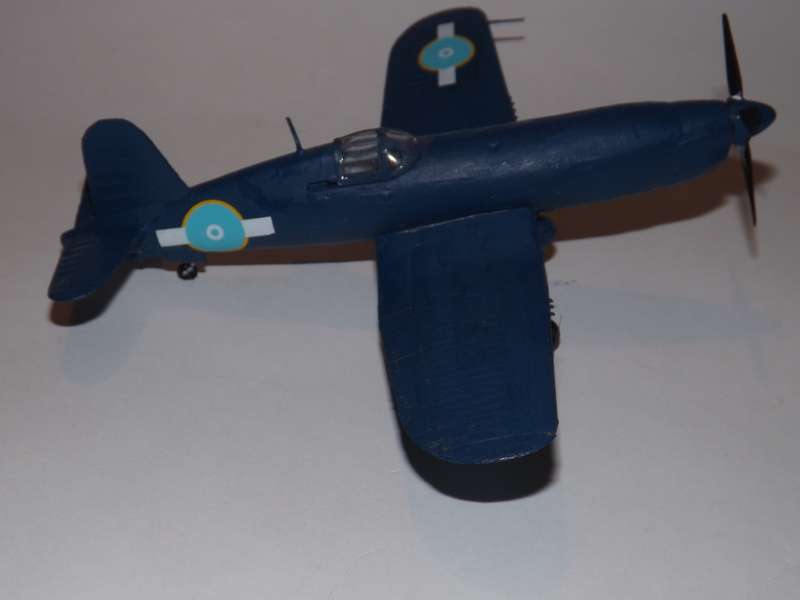


The Kit
Based on a drawing by ysi_maniac:
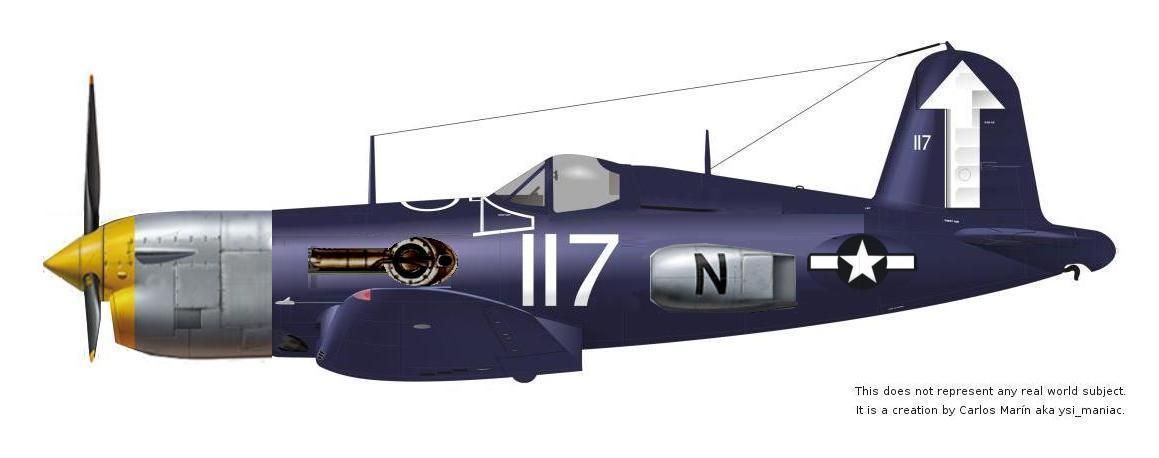
The model consists of a Revel F4U1 kit, coupled with a resin P-38 nose. The decals came from Knightflyer. Painted in Tamiya Acylics with a hairy stick.
You are using an out of date browser. It may not display this or other websites correctly.
You should upgrade or use an alternative browser.
You should upgrade or use an alternative browser.
Alternate Aircraft of Nations
- Thread starter Count of Crisco
- Start date
Well, that should give the Skua Mk III? a good stiff kick in the shorts. Probably have to do some other frame mods to accommodate the big jump in up-front weight.
It keeps it useful until 1942 as a dive bomber at least.
Driftless
Donor
I had plugged this entry in on another thread
Here's my quick take on an alternative Curtis P-31, the USAAC's first cantilever-winged, retractable landing gear fighter. It was a bit of a dog, using the Curtis V-1570 Conqueror in the prototype, and a bit heavy for it's layout, but it was a start, beating out Boeing's P-26 "Peashooter"

The historic XP-31 had struts, wires, skirted landing gear. Here, the wing and elevator are strengthened, removing the need for struts and wires, and the landing gear made retractable. Also, historically, by the time Curtis got the XP-31 ready to go, the Peashooter was already selected, or nearly so.
Here's my quick take on an alternative Curtis P-31, the USAAC's first cantilever-winged, retractable landing gear fighter. It was a bit of a dog, using the Curtis V-1570 Conqueror in the prototype, and a bit heavy for it's layout, but it was a start, beating out Boeing's P-26 "Peashooter"
The historic XP-31 had struts, wires, skirted landing gear. Here, the wing and elevator are strengthened, removing the need for struts and wires, and the landing gear made retractable. Also, historically, by the time Curtis got the XP-31 ready to go, the Peashooter was already selected, or nearly so.
Here's the real aircraft. Definitely a missed opportunity, so close to a world beater but yet so far.


Last edited:
Driftless
Donor
A bit of whimsy:
SPAD ME (monoplane experimental) 1917
An experimental construction combining the monoplane format and laminated wood monocoque construction of the earlier Deperdussin Monocoque racer with the higher powered Hispano-Suiza 8d v-8 engine. The craft was given a circular radiator and ailerons that other current SPADs were using. A small prop spinner was included to improve airflow, without letting the engine overheat(the original Deperdussin had a large spinner nearly the diameter of the rotary engine).
The design goal was speed and sturdiness. The prototype showed promise, but had some initial stability issues to work through, so production as a fighter was delayed till the spring of 1918, and first rollout to the Escadrilles in August of 1918. Two Escadrilles were able to participate in the final offensives of the war.
Immediately following the war, when French agents were able to get a look at Hugo Junkers cantilever winged monoplane J-1, ideas "borrowed" from that plane would spawn the next generation of Bleriot-SPAD fighters.
SPAD ME (monoplane experimental) 1917
An experimental construction combining the monoplane format and laminated wood monocoque construction of the earlier Deperdussin Monocoque racer with the higher powered Hispano-Suiza 8d v-8 engine. The craft was given a circular radiator and ailerons that other current SPADs were using. A small prop spinner was included to improve airflow, without letting the engine overheat(the original Deperdussin had a large spinner nearly the diameter of the rotary engine).
The design goal was speed and sturdiness. The prototype showed promise, but had some initial stability issues to work through, so production as a fighter was delayed till the spring of 1918, and first rollout to the Escadrilles in August of 1918. Two Escadrilles were able to participate in the final offensives of the war.
Immediately following the war, when French agents were able to get a look at Hugo Junkers cantilever winged monoplane J-1, ideas "borrowed" from that plane would spawn the next generation of Bleriot-SPAD fighters.
Last edited:
CA-15 “Kangaroo” 76 Squadron, 1950
After successfully transforming the Wirraway into an emergency fighter in 1942 known as the Boomerang, Commonwealth Aircraft Corporation under designer Fred David (an Austrian Jew who had also designed aircraft in Japan before the war) began work on what was to be the CAC 15, a purposed designed interceptor. The Boomerang had suffered because of the choice of engine, which lacking a turbocharger did not supply sufficient power at altitude.
The CAC 15 was to fix that. David, impressed by reports of the Fw190 from overseas had originally planned to use a radial engine. However, a shortage of such powerful engines because of the war situation had forced CAC to turn to the inline Griffon engine instead. The Griffon powered prototype however did not fly until 1945, just before the end of the war. It was a successful design and capable of over 448 mph. The RAAF by this time was looking more seriously at alternative designs and decided against the CAC 15, in favour of the P-51 Mustang produced under license in Australia. Jet engined aircraft were also in the offing and possessed superior climb and speed characteristics.
However in 1946 100 CAC 15s were ordered as they were superior to the P-51 in climb and speed at extreme altitude. The CA15 as it became officially known equipped three RAAF squadrons in the years 1948 until 1953. Two of those squadrons served as part of BCOFJ (British Commonwealth Occupation Forces Japan) in Japan. They also served briefly in the Korean War as part of the UN forces employed there. They were replaced by Meteor Jet Fighters in 1951. The CA15 was christened with the nickname “Kangaroo” by some wag in the press. This was never it’s official RAAF nomenclature.
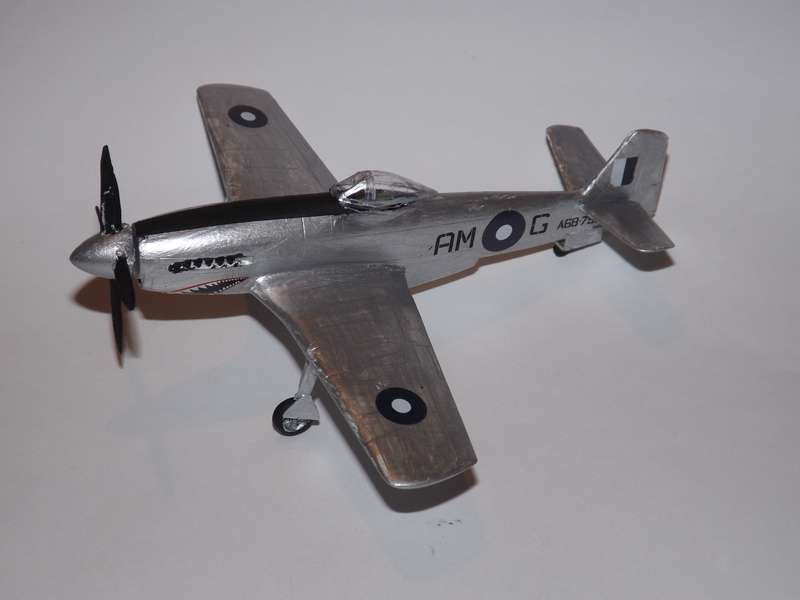
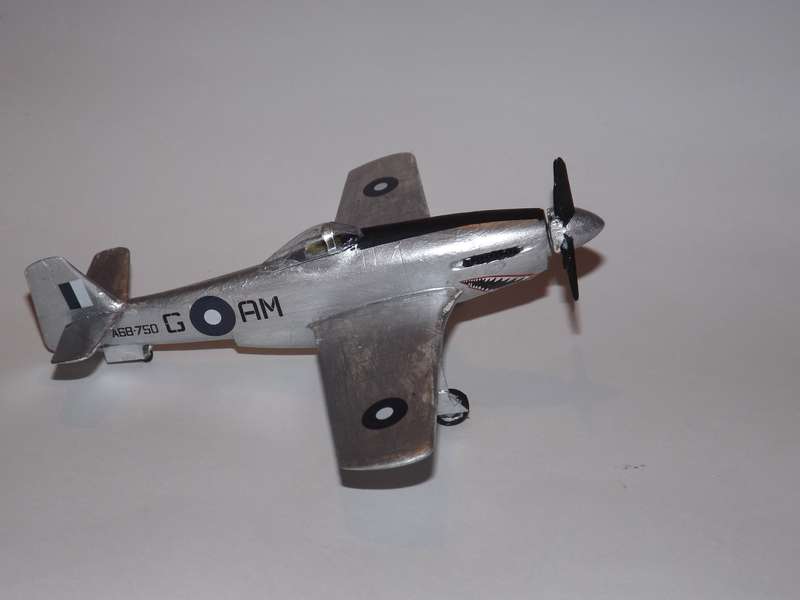
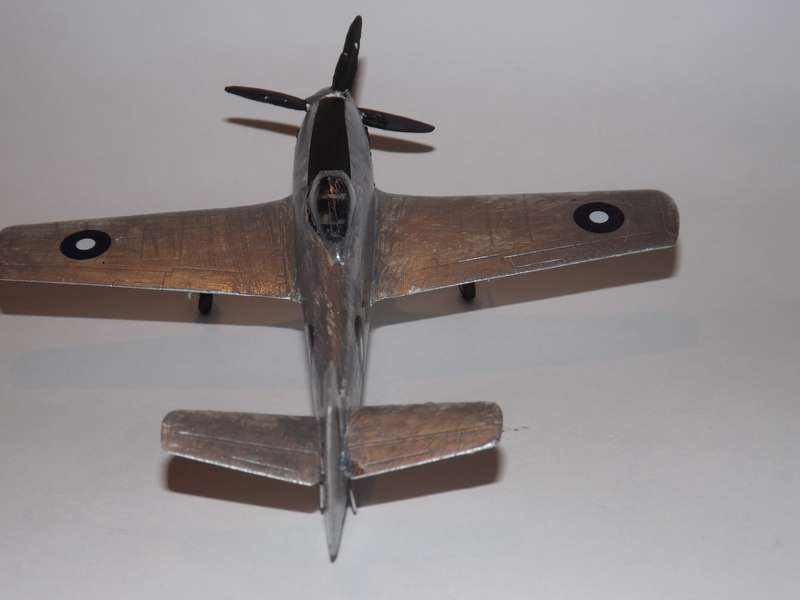
The Kit
The kit is a CMK resin one. It depicts an aircraft from 76 Squadron RAAF. It has taken over two years to build. It was not a happy experience with two propeller blades breaking and needing replacement. It was brush painted using Vallejo acrylics.
After successfully transforming the Wirraway into an emergency fighter in 1942 known as the Boomerang, Commonwealth Aircraft Corporation under designer Fred David (an Austrian Jew who had also designed aircraft in Japan before the war) began work on what was to be the CAC 15, a purposed designed interceptor. The Boomerang had suffered because of the choice of engine, which lacking a turbocharger did not supply sufficient power at altitude.
The CAC 15 was to fix that. David, impressed by reports of the Fw190 from overseas had originally planned to use a radial engine. However, a shortage of such powerful engines because of the war situation had forced CAC to turn to the inline Griffon engine instead. The Griffon powered prototype however did not fly until 1945, just before the end of the war. It was a successful design and capable of over 448 mph. The RAAF by this time was looking more seriously at alternative designs and decided against the CAC 15, in favour of the P-51 Mustang produced under license in Australia. Jet engined aircraft were also in the offing and possessed superior climb and speed characteristics.
However in 1946 100 CAC 15s were ordered as they were superior to the P-51 in climb and speed at extreme altitude. The CA15 as it became officially known equipped three RAAF squadrons in the years 1948 until 1953. Two of those squadrons served as part of BCOFJ (British Commonwealth Occupation Forces Japan) in Japan. They also served briefly in the Korean War as part of the UN forces employed there. They were replaced by Meteor Jet Fighters in 1951. The CA15 was christened with the nickname “Kangaroo” by some wag in the press. This was never it’s official RAAF nomenclature.



The Kit
The kit is a CMK resin one. It depicts an aircraft from 76 Squadron RAAF. It has taken over two years to build. It was not a happy experience with two propeller blades breaking and needing replacement. It was brush painted using Vallejo acrylics.
Fokker F27 Troopship Mk.II in Australian Coast Guard Service
After the Tampa affair, and the declaration of the War on Terrorism, in 2001 Kim Beazley announced that the Australian Labor Party, if in government, would establish an Australian Coast Guard "responsible for conducting Australia's coastal surveillance and meeting Australia's maritime protection needs, including in relation to illegal immigration, drugs, fisheries, and quarantine-related issues". This plan met with criticism. Defence Minister Peter Reith under the Liberal-Coalition Government criticised Beazley for stating that an Australian Coast Guard both will and will not be an "answer to the question of people smuggling". The plan was criticised by the Australian government, on the grounds that it would either be prohibitively expensive or inadequate to the task. Later, the motives for the establishment of an Australian Coast Guard were interpreted by some as "a plan to extend the capabilities of the Australian Federal Police."
After the defeat of the Howard Government in the 2003 election, the ALP Government, let by Simon Crean instituted the Australian Coast Guard – a subsidiary organisation, run by the Australian Federal Police and intended to protect Australia's coast line from incursion by illegal people smugglers and drug runners and to rescue wayward seafarers. Equipped initially with mainly cast off equipment from the RAAF and the RAN, the ACG was intended to secure the coastline out to 1,000 km.
In this case, we have a Fokker F27 Troopship Mk.II. The Fokker was originally used by the RAAF as a light, tactical transport and was designed to be common with the civilian F27 Friendship. The RAAF was the launch customer for the Troopship Mk.II which introduced a large ramp at the rear to facilitate tactical loading directly onto the back of a medium truck.
By the time of the formation of the ACG, the RAAF were looking for replacements for the elderly Troopships. They were considered perfect for Coast Guard use and were adopted in squadron strength, where they still serve today.
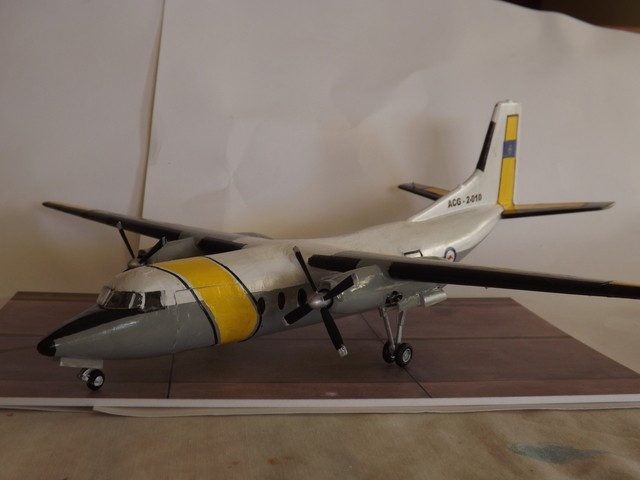
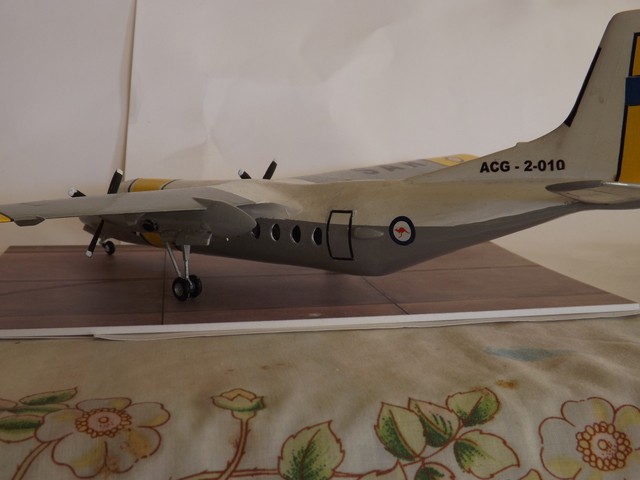
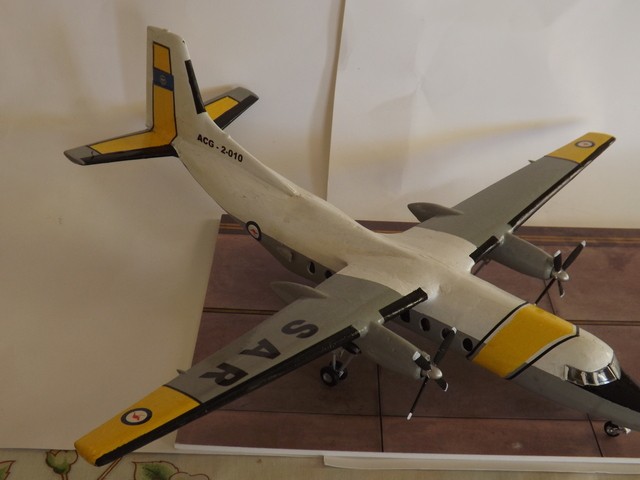
After the Tampa affair, and the declaration of the War on Terrorism, in 2001 Kim Beazley announced that the Australian Labor Party, if in government, would establish an Australian Coast Guard "responsible for conducting Australia's coastal surveillance and meeting Australia's maritime protection needs, including in relation to illegal immigration, drugs, fisheries, and quarantine-related issues". This plan met with criticism. Defence Minister Peter Reith under the Liberal-Coalition Government criticised Beazley for stating that an Australian Coast Guard both will and will not be an "answer to the question of people smuggling". The plan was criticised by the Australian government, on the grounds that it would either be prohibitively expensive or inadequate to the task. Later, the motives for the establishment of an Australian Coast Guard were interpreted by some as "a plan to extend the capabilities of the Australian Federal Police."
After the defeat of the Howard Government in the 2003 election, the ALP Government, let by Simon Crean instituted the Australian Coast Guard – a subsidiary organisation, run by the Australian Federal Police and intended to protect Australia's coast line from incursion by illegal people smugglers and drug runners and to rescue wayward seafarers. Equipped initially with mainly cast off equipment from the RAAF and the RAN, the ACG was intended to secure the coastline out to 1,000 km.
In this case, we have a Fokker F27 Troopship Mk.II. The Fokker was originally used by the RAAF as a light, tactical transport and was designed to be common with the civilian F27 Friendship. The RAAF was the launch customer for the Troopship Mk.II which introduced a large ramp at the rear to facilitate tactical loading directly onto the back of a medium truck.
By the time of the formation of the ACG, the RAAF were looking for replacements for the elderly Troopships. They were considered perfect for Coast Guard use and were adopted in squadron strength, where they still serve today.



He 100 with HS 12Y engine.
Story might go like this: RLM gives a chance to the He 100 by Spring of 1939, but on condition that Heinkel gets creative on engine choice and to forget the system of cooling the He 100 uses. So they nick the HS 12Y from the Avia B.135, all together with the 'classic' cooling system; the DVL prop is used on the He 100. One MG FF is installed, as well as two MGs in the wing roots).
Because of it's superior streamlining vs. Bf 109E, the turn of speed is the same (550+ km/h) despite the power deficit, while the range is a bit better even on less fuel (a nod, at least in eyes of LW logisticians). Main dislike is the use of six carburetors on the HS engines.
Once shooting starts, He is made in ever-increasing quantities, though the Bf 109E is still the main fighter.

Story might go like this: RLM gives a chance to the He 100 by Spring of 1939, but on condition that Heinkel gets creative on engine choice and to forget the system of cooling the He 100 uses. So they nick the HS 12Y from the Avia B.135, all together with the 'classic' cooling system; the DVL prop is used on the He 100. One MG FF is installed, as well as two MGs in the wing roots).
Because of it's superior streamlining vs. Bf 109E, the turn of speed is the same (550+ km/h) despite the power deficit, while the range is a bit better even on less fuel (a nod, at least in eyes of LW logisticians). Main dislike is the use of six carburetors on the HS engines.
Once shooting starts, He is made in ever-increasing quantities, though the Bf 109E is still the main fighter.

I think it's main use would be as a fighter trainer and something to be flogged to Germany's East European allies.
Driftless
Donor
At some future date, could a later mark be re-engined again? Or by then, is the design passing into the tail of its career?He 100 with HS 12Y engine.
Story might go like this: RLM gives a chance to the He 100 by Spring of 1939, but on condition that Heinkel gets creative on engine choice and to forget the system of cooling the He 100 uses. So they nick the HS 12Y from the Avia B.135, all together with the 'classic' cooling system; the DVL prop is used on the He 100. One MG FF is installed, as well as two MGs in the wing roots).
Because of it's superior streamlining vs. Bf 109E, the turn of speed is the same (550+ km/h) despite the power deficit, while the range is a bit better even on less fuel (a nod, at least in eyes of LW logisticians). Main dislike is the use of six carburetors on the HS engines.
Once shooting starts, He is made in ever-increasing quantities, though the Bf 109E is still the main fighter.
View attachment 610954
At some future date, could a later mark be re-engined again? Or by then, is the design passing into the tail of its career?
By late 1940, install the French later HS 12Y versions that have improved supercharger, like the -45 or 49. This should add another 20+- km/h. The fuel injection might also add another 10 km/h? Send those aircraft to fight in North Africa or sell it to the Italians; until Spitfire is around the RAF is in a pickle situation there.
Granted, the DB 601A in the nose should propel it comfortably beyond 600 km/h, and with DB 601E the speed should be no worse than the Bf 109F4 that did 630-650 km/h.
Hawker Siddeley Gnat T.2
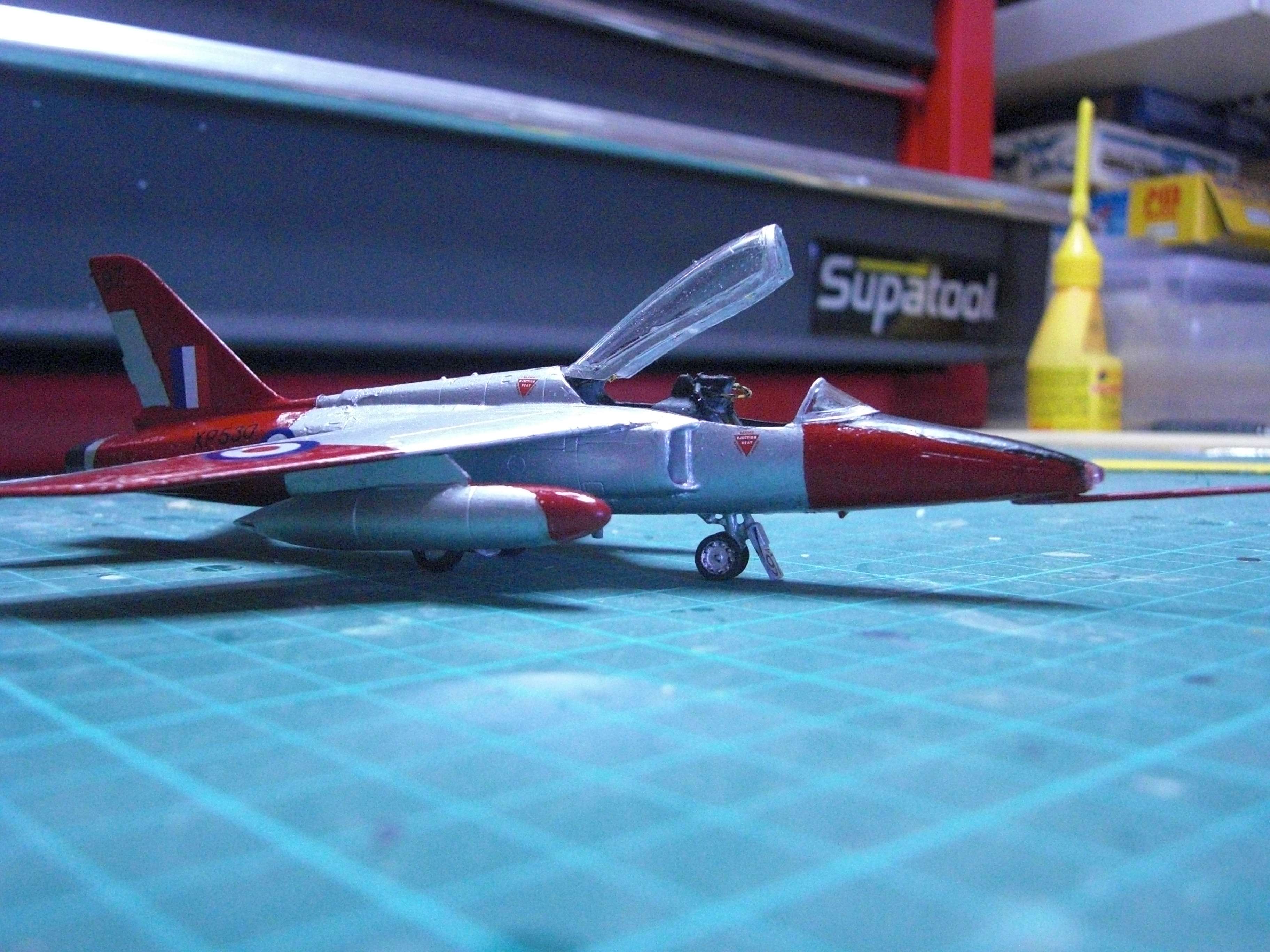
Equipped with two J-85 Turbojets, the Gnat T.2 was a development of the T.1 and designed to bring supersonic training to the RAF at a low cost.
The Kit
The kit is the new Airfix Gnat. I know everybody raved about it when it came out but I found it had terrible fit problems, particularly with the upper-wing to the fuselage.

Equipped with two J-85 Turbojets, the Gnat T.2 was a development of the T.1 and designed to bring supersonic training to the RAF at a low cost.
The Kit
The kit is the new Airfix Gnat. I know everybody raved about it when it came out but I found it had terrible fit problems, particularly with the upper-wing to the fuselage.
The Folland Gnat Mk.1 – יַתוּשׁ - in Israeli Air Force Service
The Folland Gnat is a British compact swept-wing subsonic fighter aircraft developed and produced by Folland Aircraft. Envisioned as an affordable light fighter in contrast to the rising cost and size of typical combat aircraft, it was procured as a trainer aircraft for the Royal Air Force (RAF) as well as by export customers, who used the Gnat in both combat and training capacities.
Designed by W.E.W. Petter, the Gnat has its origins in the preceding private venture Folland Midge. The issuing of Operational Requirement OR.303 by the British Air Ministry served to motivate the type's development, the Gnat was later submitted to meet this requirement. Its design allowed for its construction and maintenance tasks to be carried out without specialised tools, making it suitable for use in countries that had not yet become highly industrialised. The Gnat has been viewed as a major motivating factor towards the issuing of the NATO NBMR-1 requirement, which sought to make available a common strike/attack light fighter with which to equip the air forces of the various NATO members.
Although never used as a fighter by the Royal Air Force (RAF), the Gnat T.1 jet trainer variant was adopted and operated for some time. In the United Kingdom, the Gnat became well known due to its prominent use as the display aircraft of the RAF's Red Arrows aerobatic team. The Gnat F.1 was exported to Israel, Finland, Yugoslavia and India. The Indian Air Force became the largest operator and eventually manufactured the aircraft under licence. Impressed by its performance during combat, India proceeded to develop the improved HAL Ajeet, a modified variant of the Gnat. In British service, the Gnat was replaced by the Hawker Siddeley Hawk.
As already related here, the British became the major suppliers of Israel's defence equipment after the 1956 Suez Crisis saw the end of the Egyptian Nasser regime. As part of that role, the Folland Gnat was chosen by the Israeli Air Force as part of the rapid industrialisation of the Jewish homeland. It was small, light and not overly technical for production in Israel. Armed with two 30mm ADEN cannon and two Sidewinder Air-to-Air missiles, coupled with a light weight radar set, the יַתוּשׁ (Hebrew for “Gnat”) was considered an ideal starting point for the Jewish aero-industry.
The Israeli Air Force was impressed by the Gnat's performance and fought successfully in the 1967 and 1973 wars against the opposing Arab forces, but the aircraft was recognised to have problems including hydraulics and unreliable control systems. To address these issues, the Israeli Air Force issued a requirement for an improved "Gnat II" in 1972, at first specifying that the new version was to be optimised as an interceptor, but then expanding the specification to include the ground-attack role. Over 175 of the built licensed version, the יַבחוּשׁ, were produced in Tel Aviv.
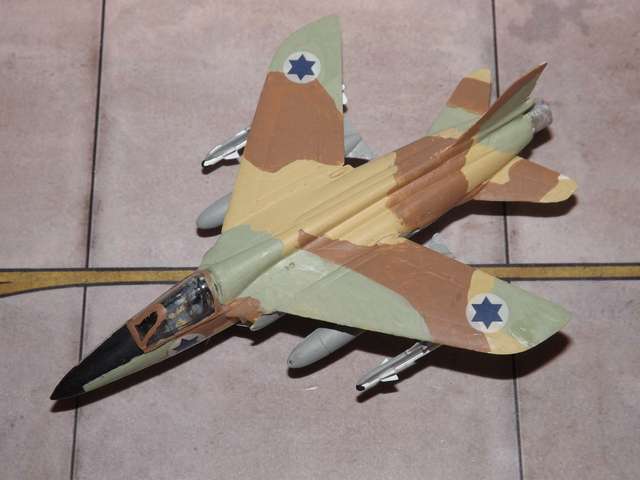
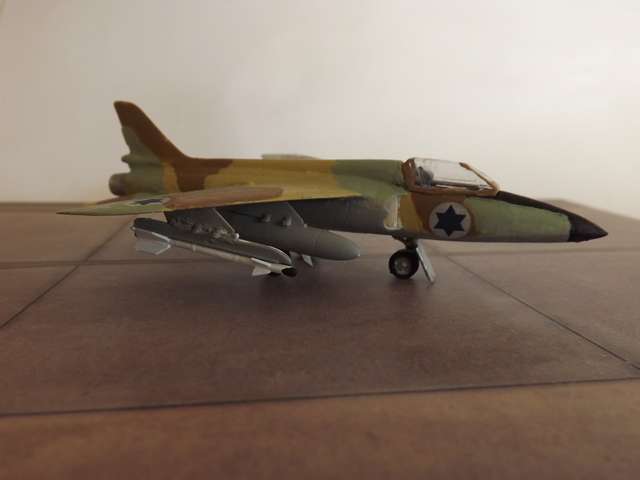
The Model
The model is the Olimp 1/72 Gnat Ajeet, the Indian version of the Gnat. However, where it differs is in the additional tail pipe, which is modelled on that added to the A-4 Skyhawk by the Israelis to improve protection of the engine from IR Guided Missiles. It has had two AIM-9B Sidewinder missiles added and a new radome has been painted on the model. Due to the carpet monster temporarily eating one of the mainwheels, I appealed for a set of undercarriage and receive a set from both TomZ and JayBee. Much appreciated. Of course, after their arrival, the wheel turned up on my desk. The model is tiny compared to most other aircraft of the period.
The Gnat was an actual proposal for the Israelis however, after 1956, in this trouserleg of time, the British decided being friendly with the Arabs was more important than being friendly with the Israelis and so the Israelis turned to the French for their aircraft.
The Folland Gnat is a British compact swept-wing subsonic fighter aircraft developed and produced by Folland Aircraft. Envisioned as an affordable light fighter in contrast to the rising cost and size of typical combat aircraft, it was procured as a trainer aircraft for the Royal Air Force (RAF) as well as by export customers, who used the Gnat in both combat and training capacities.
Designed by W.E.W. Petter, the Gnat has its origins in the preceding private venture Folland Midge. The issuing of Operational Requirement OR.303 by the British Air Ministry served to motivate the type's development, the Gnat was later submitted to meet this requirement. Its design allowed for its construction and maintenance tasks to be carried out without specialised tools, making it suitable for use in countries that had not yet become highly industrialised. The Gnat has been viewed as a major motivating factor towards the issuing of the NATO NBMR-1 requirement, which sought to make available a common strike/attack light fighter with which to equip the air forces of the various NATO members.
Although never used as a fighter by the Royal Air Force (RAF), the Gnat T.1 jet trainer variant was adopted and operated for some time. In the United Kingdom, the Gnat became well known due to its prominent use as the display aircraft of the RAF's Red Arrows aerobatic team. The Gnat F.1 was exported to Israel, Finland, Yugoslavia and India. The Indian Air Force became the largest operator and eventually manufactured the aircraft under licence. Impressed by its performance during combat, India proceeded to develop the improved HAL Ajeet, a modified variant of the Gnat. In British service, the Gnat was replaced by the Hawker Siddeley Hawk.
As already related here, the British became the major suppliers of Israel's defence equipment after the 1956 Suez Crisis saw the end of the Egyptian Nasser regime. As part of that role, the Folland Gnat was chosen by the Israeli Air Force as part of the rapid industrialisation of the Jewish homeland. It was small, light and not overly technical for production in Israel. Armed with two 30mm ADEN cannon and two Sidewinder Air-to-Air missiles, coupled with a light weight radar set, the יַתוּשׁ (Hebrew for “Gnat”) was considered an ideal starting point for the Jewish aero-industry.
The Israeli Air Force was impressed by the Gnat's performance and fought successfully in the 1967 and 1973 wars against the opposing Arab forces, but the aircraft was recognised to have problems including hydraulics and unreliable control systems. To address these issues, the Israeli Air Force issued a requirement for an improved "Gnat II" in 1972, at first specifying that the new version was to be optimised as an interceptor, but then expanding the specification to include the ground-attack role. Over 175 of the built licensed version, the יַבחוּשׁ, were produced in Tel Aviv.


The Model
The model is the Olimp 1/72 Gnat Ajeet, the Indian version of the Gnat. However, where it differs is in the additional tail pipe, which is modelled on that added to the A-4 Skyhawk by the Israelis to improve protection of the engine from IR Guided Missiles. It has had two AIM-9B Sidewinder missiles added and a new radome has been painted on the model. Due to the carpet monster temporarily eating one of the mainwheels, I appealed for a set of undercarriage and receive a set from both TomZ and JayBee. Much appreciated. Of course, after their arrival, the wheel turned up on my desk. The model is tiny compared to most other aircraft of the period.
The Gnat was an actual proposal for the Israelis however, after 1956, in this trouserleg of time, the British decided being friendly with the Arabs was more important than being friendly with the Israelis and so the Israelis turned to the French for their aircraft.
Hawker Siddeley Gnat T.2

Equipped with two J-85 Turbojets, the Gnat T.2 was a development of the T.1 and designed to bring supersonic training to the RAF at a low cost.
The Kit
The kit is the new Airfix Gnat. I know everybody raved about it when it came out but I found it had terrible fit problems, particularly with the upper-wing to the fuselage.
These remind me of the Jets used in the movie Hot Shots.The Folland Gnat Mk.1 – יַתוּשׁ - in Israeli Air Force Service
The Folland Gnat is a British compact swept-wing subsonic fighter aircraft developed and produced by Folland Aircraft. Envisioned as an affordable light fighter in contrast to the rising cost and size of typical combat aircraft, it was procured as a trainer aircraft for the Royal Air Force (RAF) as well as by export customers, who used the Gnat in both combat and training capacities.
Designed by W.E.W. Petter, the Gnat has its origins in the preceding private venture Folland Midge. The issuing of Operational Requirement OR.303 by the British Air Ministry served to motivate the type's development, the Gnat was later submitted to meet this requirement. Its design allowed for its construction and maintenance tasks to be carried out without specialised tools, making it suitable for use in countries that had not yet become highly industrialised. The Gnat has been viewed as a major motivating factor towards the issuing of the NATO NBMR-1 requirement, which sought to make available a common strike/attack light fighter with which to equip the air forces of the various NATO members.
Although never used as a fighter by the Royal Air Force (RAF), the Gnat T.1 jet trainer variant was adopted and operated for some time. In the United Kingdom, the Gnat became well known due to its prominent use as the display aircraft of the RAF's Red Arrows aerobatic team. The Gnat F.1 was exported to Israel, Finland, Yugoslavia and India. The Indian Air Force became the largest operator and eventually manufactured the aircraft under licence. Impressed by its performance during combat, India proceeded to develop the improved HAL Ajeet, a modified variant of the Gnat. In British service, the Gnat was replaced by the Hawker Siddeley Hawk.
As already related here, the British became the major suppliers of Israel's defence equipment after the 1956 Suez Crisis saw the end of the Egyptian Nasser regime. As part of that role, the Folland Gnat was chosen by the Israeli Air Force as part of the rapid industrialisation of the Jewish homeland. It was small, light and not overly technical for production in Israel. Armed with two 30mm ADEN cannon and two Sidewinder Air-to-Air missiles, coupled with a light weight radar set, the יַתוּשׁ (Hebrew for “Gnat”) was considered an ideal starting point for the Jewish aero-industry.
The Israeli Air Force was impressed by the Gnat's performance and fought successfully in the 1967 and 1973 wars against the opposing Arab forces, but the aircraft was recognised to have problems including hydraulics and unreliable control systems. To address these issues, the Israeli Air Force issued a requirement for an improved "Gnat II" in 1972, at first specifying that the new version was to be optimised as an interceptor, but then expanding the specification to include the ground-attack role. Over 175 of the built licensed version, the יַבחוּשׁ, were produced in Tel Aviv.


The Model
The model is the Olimp 1/72 Gnat Ajeet, the Indian version of the Gnat. However, where it differs is in the additional tail pipe, which is modelled on that added to the A-4 Skyhawk by the Israelis to improve protection of the engine from IR Guided Missiles. It has had two AIM-9B Sidewinder missiles added and a new radome has been painted on the model. Due to the carpet monster temporarily eating one of the mainwheels, I appealed for a set of undercarriage and receive a set from both TomZ and JayBee. Much appreciated. Of course, after their arrival, the wheel turned up on my desk. The model is tiny compared to most other aircraft of the period.
The Gnat was an actual proposal for the Israelis however, after 1956, in this trouserleg of time, the British decided being friendly with the Arabs was more important than being friendly with the Israelis and so the Israelis turned to the French for their aircraft.
Ramontxo
Donor
Cant you give an overview of the Gnat 2 specifications?The Folland Gnat Mk.1 – יַתוּשׁ - in Israeli Air Force Service
The Folland Gnat is a British compact swept-wing subsonic fighter aircraft developed and produced by Folland Aircraft. Envisioned as an affordable light fighter in contrast to the rising cost and size of typical combat aircraft, it was procured as a trainer aircraft for the Royal Air Force (RAF) as well as by export customers, who used the Gnat in both combat and training capacities.
Designed by W.E.W. Petter, the Gnat has its origins in the preceding private venture Folland Midge. The issuing of Operational Requirement OR.303 by the British Air Ministry served to motivate the type's development, the Gnat was later submitted to meet this requirement. Its design allowed for its construction and maintenance tasks to be carried out without specialised tools, making it suitable for use in countries that had not yet become highly industrialised. The Gnat has been viewed as a major motivating factor towards the issuing of the NATO NBMR-1 requirement, which sought to make available a common strike/attack light fighter with which to equip the air forces of the various NATO members.
Although never used as a fighter by the Royal Air Force (RAF), the Gnat T.1 jet trainer variant was adopted and operated for some time. In the United Kingdom, the Gnat became well known due to its prominent use as the display aircraft of the RAF's Red Arrows aerobatic team. The Gnat F.1 was exported to Israel, Finland, Yugoslavia and India. The Indian Air Force became the largest operator and eventually manufactured the aircraft under licence. Impressed by its performance during combat, India proceeded to develop the improved HAL Ajeet, a modified variant of the Gnat. In British service, the Gnat was replaced by the Hawker Siddeley Hawk.
As already related here, the British became the major suppliers of Israel's defence equipment after the 1956 Suez Crisis saw the end of the Egyptian Nasser regime. As part of that role, the Folland Gnat was chosen by the Israeli Air Force as part of the rapid industrialisation of the Jewish homeland. It was small, light and not overly technical for production in Israel. Armed with two 30mm ADEN cannon and two Sidewinder Air-to-Air missiles, coupled with a light weight radar set, the יַתוּשׁ (Hebrew for “Gnat”) was considered an ideal starting point for the Jewish aero-industry.
The Israeli Air Force was impressed by the Gnat's performance and fought successfully in the 1967 and 1973 wars against the opposing Arab forces, but the aircraft was recognised to have problems including hydraulics and unreliable control systems. To address these issues, the Israeli Air Force issued a requirement for an improved "Gnat II" in 1972, at first specifying that the new version was to be optimised as an interceptor, but then expanding the specification to include the ground-attack role. Over 175 of the built licensed version, the יַבחוּשׁ, were produced in Tel Aviv.


The Model
The model is the Olimp 1/72 Gnat Ajeet, the Indian version of the Gnat. However, where it differs is in the additional tail pipe, which is modelled on that added to the A-4 Skyhawk by the Israelis to improve protection of the engine from IR Guided Missiles. It has had two AIM-9B Sidewinder missiles added and a new radome has been painted on the model. Due to the carpet monster temporarily eating one of the mainwheels, I appealed for a set of undercarriage and receive a set from both TomZ and JayBee. Much appreciated. Of course, after their arrival, the wheel turned up on my desk. The model is tiny compared to most other aircraft of the period.
The Gnat was an actual proposal for the Israelis however, after 1956, in this trouserleg of time, the British decided being friendly with the Arabs was more important than being friendly with the Israelis and so the Israelis turned to the French for their aircraft.
Does India make their own version of the Gnat T.2?Hawker Siddeley Gnat T.2

Equipped with two J-85 Turbojets, the Gnat T.2 was a development of the T.1 and designed to bring supersonic training to the RAF at a low cost.
The Kit
The kit is the new Airfix Gnat. I know everybody raved about it when it came out but I found it had terrible fit problems, particularly with the upper-wing to the fuselage.
They did so in OTL. It was the HAL Ajeet.Does India make their own version of the Gnat T.2?
I was referring the the alt history T.2 presented above. I'm believe that the T.2 is hypothetical.They did so in OTL. It was the HAL Ajeet.
Share:
